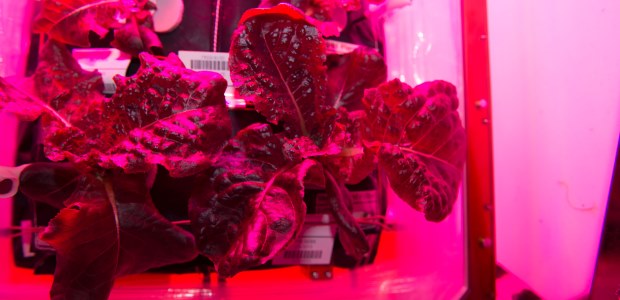
ISS Crew Tasting Homegrown Greens Today
NASA announced they will eat half of a crop of "Outredgeous" red romaine lettuce that was grown in the Veggie plant growth system on the International Space Station.
Six people working aboard the International Space Station on Aug. 10 will get their first taste of fresh, leafy greens that have grown there in a plant growth system named Veggie. They have harvested a crop of "Outredgeous" red romaine lettuce and will consume half of it, NASA announced.
Growing some of their own food has obvious benefits, including psychological benefits for astronauts on long, distant missions from Earth, including a mission to Mars, according to the agency. The six crew members of ISS Expedition 44 will clean the greens with citric acid-based, food safe sanitizing wipes before eating them. The other half of the crop will be packaged and frozen on the station until it can be returned to Earth for scientific analysis.
This plant experiment is named Veg-01; it is studying the in-orbit function and performance of Veggie and its rooting "pillows," which contain the seeds.
The first pillows were activated on the ISS in May 2014, and those plants were returned to Earth in October 2014 to undergo food safety analysis. The second Veg-01 plant pillows were activated by astronaut Scott Kelly on July 8 and grew for 33 days before being harvested.
NASA describes Veggie, which was developed by Orbital Technologies Corp., as a collapsible, expandable unit with a flat panel light bank that includes red, blue, and green LEDs for plant growth and crew observation. "Using LED lights to grow plants was an idea that originated with NASA as far back as the late 1990s, according to Dr. Ray Wheeler, lead for Advanced Life Support activities in the Exploration Research and Technology Programs Office at Kennedy [Space Center]. Wheeler worked with engineers and collaborators to help develop the Veggie unit from a Small Business Innovative Research project with ORBITEC. Dr. Gioia Massa is the NASA payload scientist for Veggie at Kennedy. Massa and others worked to get the flight unit developed and certified for use on the space station. The purple/pinkish hue surrounding the plants in Veggie is the result of a combination of the red and blue lights, which by design emit more light than the green LEDs. Green LEDS were added so the plants look like edible food rather than weird purple plants," according to the agency's news release.
"Blue and red wavelengths are the minimum needed to get good plant growth," Wheeler said. "They are probably the most efficient in terms of electrical power conversion. The green LEDs help to enhance the human visual perception of the plants, but they don't put out as much light as the reds and blues."
"There is evidence that supports fresh foods, such as tomatoes, blueberries, and red lettuce, are a good source of antioxidants. Having fresh food like these available in space could have a positive impact on people's moods and also could provide some protection against radiation in space," Wheeler said.
Massa said the microbiological food safety analysis "looks very good on the first Veg-01 crop of romaine lettuce."